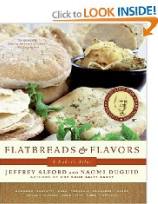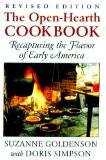-
History of:
- Resources about:
- More:
- Baby walkers
- Bakehouses
- Bed warmers
- Beer, ale mullers
- Besoms, broom-making
- Box, cabinet, and press beds
- Butter crocks, coolers
- Candle snuffers, tallow
- Clothes horses, airers
- Cooking on a peat fire
- Drying grounds
- Enamel cookware
- Fireplaces
- Irons for frills & ruffles
- Knitting sheaths, belts
- Laundry starch
- Log cabin beds
- Lye and chamber-lye
- Mangles
- Marseilles quilts
- Medieval beds
- Rag rugs
- Rushlights, dips & nips
- Straw mattresses
- Sugar cutters - nips & tongs
- Tablecloths
- Tinderboxes
- Washing bats and beetles
- Washing dollies
- List of all articles
Subscribe to RSS feed or get email updates.
In Scotland, amongst the rural population generally, the girdle takes the place of the oven, the bannock of the loaf...
F. Marian McNeill, The Scots Kitchen, 1929
They were baking oat-bread, which they cut into quarters, and half-baked over the fire, and half-toasted before it...
Dorothy Wordsworth, diary entry while visiting Scotland in 1803

Flatbreads & Flavors: A Baker's Atlas from Amazon.com
...on their horse between the saddle and the panel they truss a broad plate of metal, and behind the saddle they will have a little sack full of oatmeal...then they lay this plate on the fire and temper a little of the oatmeal; and when the plate is hot, they cast of the thin paste thereon, and so make a little cake...
14th century Scottish soliders described by Froissart
The Open-Hearth Cookbook: Recapturing the Flavor of Early America
Baking over an open fire
Bannocks, branders, bannock spades and stones
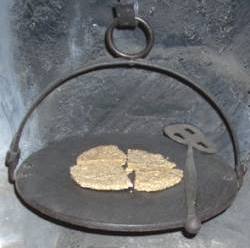 Flat bread cooked on a
metal plate over a fire may seem like a simple style of baking, but there are some
even more basic ways of turning flour into bread. Ancient alternatives include laying
the dough on hot embers, or even in amongst the ashes. You can also bake dough on
a hot stone placed by an open hearth or balanced over flames.
Flat bread cooked on a
metal plate over a fire may seem like a simple style of baking, but there are some
even more basic ways of turning flour into bread. Ancient alternatives include laying
the dough on hot embers, or even in amongst the ashes. You can also bake dough on
a hot stone placed by an open hearth or balanced over flames.
In many parts of the world flat bread is just as common as oven-baked bread - or more common. In Scotland, it remained an everyday recipe for longer than in many parts of the English-speaking world. Many households, especially in rural areas, had an open hearth well into the 19th century, some also in the 20th. There and in other regions of northern Europe baking was often done on fires burning peat.
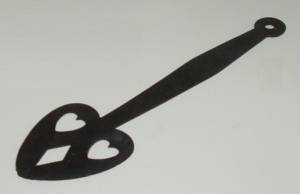 Oat and barley
bread was made on a metal "brander" or girdle (also called gridiron or griddle)
hanging over the fire on a chain and hook, called a swey in Scotland if it
was hinged and adjustable. Before metal girdles were standard household items, bread
was baked on a stone set at the fireside: a
bannock-stane or bannock-stone. The dough sometimes used a proportion of
pea flour.
Oat and barley
bread was made on a metal "brander" or girdle (also called gridiron or griddle)
hanging over the fire on a chain and hook, called a swey in Scotland if it
was hinged and adjustable. Before metal girdles were standard household items, bread
was baked on a stone set at the fireside: a
bannock-stane or bannock-stone. The dough sometimes used a proportion of
pea flour.
Bannock is the traditional Scots name for bread made this way, which can range from sweet fruit loaves raised with yeast through soda-raised scones to thin flat oatcakes. Ancestors of the word bannock include Gaelic bannach and Latin panicium.
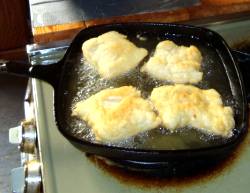 The name travelled with Scots settlers
to North America where bannock now means a kind of "fry-bread", cooked
in a fatty pan over direct heat, known in Canada and the USA. (See picture right.)
Whether the settlers taught the aboriginal peoples to cook this bread is disputed.
Almost certainly they already had similar ways of preparing food, but with different
ingredients.
The name travelled with Scots settlers
to North America where bannock now means a kind of "fry-bread", cooked
in a fatty pan over direct heat, known in Canada and the USA. (See picture right.)
Whether the settlers taught the aboriginal peoples to cook this bread is disputed.
Almost certainly they already had similar ways of preparing food, but with different
ingredients.
Scottish bannocks are not fried in fat, but the girdle used to be greased with mutton fat to prevent sticking. A bannock spade (see picture above) was used for turning and handling the bread, a bit like a spatula or an oven peel. These were often heart-shaped and a traditional Scottish lover's gift - from man to woman, of course.
Tortilla, chapati, pita, and other flat breads cooked on hot metal
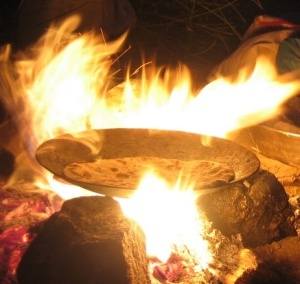 The Guatemalan
tortilla (left), Indian chapati and middle-eastern pita (below right) are just three
of the world's other breads cooked on a flat metal surface in the same way as a
traditional bannock. There's a good start on a "flat breads of the world" list
here, but some of
them are typically baked in an oven or fried in generous amounts of oil.
The Guatemalan
tortilla (left), Indian chapati and middle-eastern pita (below right) are just three
of the world's other breads cooked on a flat metal surface in the same way as a
traditional bannock. There's a good start on a "flat breads of the world" list
here, but some of
them are typically baked in an oven or fried in generous amounts of oil.
...village bread...is made in large round scones, hardly thicker than a sheet of brown paper, and cooked for about forty seconds on an iron griddle.
Mrs. W. M. Ramsay, Everyday Life in Turkey, 1897
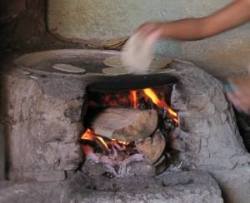 Many grains with low gluten content that could not rise if mixed with yeast make
good flat bread: millet, buckwheat etc. Flour from roots can also be made into bread
by the bannock treatment - tapioca flat breads in parts of the Americas are an example.
Many grains with low gluten content that could not rise if mixed with yeast make
good flat bread: millet, buckwheat etc. Flour from roots can also be made into bread
by the bannock treatment - tapioca flat breads in parts of the Americas are an example.
Tef [Eragrostis abyssinica]...is primarily processed into a pancake-like, fermented flat bread called injera and can be mixed with sorghum and pearl millet for another flat bread (kisra) in Sudan and Eritrea.
P. Belton, J. Taylor, Pseudocereals and less common cereals, 2002
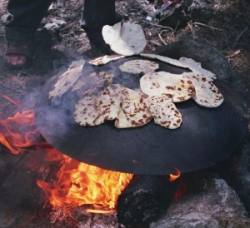 Other pages on this site about bread,
food or kitchen things:
Other pages on this site about bread,
food or kitchen things:
Bakehouses and community ovens
Baker's peels
Butter crocks
Butter churns
Cutting sugar loaf
Meat hastener
Pressure cookers
Kitchen antiques
 1 April 2009
1 April 2009
You may like our new sister site Home Things Past where you'll find articles about antiques, vintage kitchen stuff, crafts, and other things to do with home life in the past. There's space for comments and discussion too. Please do take a look and add your thoughts. (Comments don't appear instantly.)
For sources please refer to the books page, and/or the excerpts quoted on the pages of this website, and note that many links lead to museum sites. Feel free to ask if you're looking for a specific reference - feedback is always welcome anyway. Unfortunately, it's not possible to help you with queries about prices or valuation.


